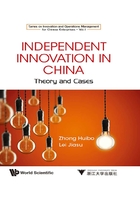
1.2 Classification of the models and types of innovation
Innovation has a great variety of characteristics and uncertainties, but it also has some established rules. The successful model of innovation is a kind of rule, thus, the academic circle and the business circle never stop researching and discussing the models of innovation.
1.2.1 Foreign classification of innovation models based on different paths
(1) “The fifth-generation model based on the path driven by innovation” proposed by Rothwell (1994)
This is the most representative explanation for the evolution of the innovation model in the foreign academia. Rothwell (1994) thinks that there are five stages that the evolutionary path of innovation has been through: i) Industrial technological innovation in the 1950s. It is mainly the linear progression of “technology push,” namely the “technology push model.” ii) Technological innovation from the late 1960s to the early 1970s. It is mainly the “market pull model,” emphasizing innovation according to the market demand. iii) In the late 1970s, the two models began to integrate, which led to the emergence of the “interactive model of innovation between technology push and market pull.” iv) From the late 1970s to the early 1980s, there emerged the innovation model of joint participation by the departments of technology, design, manufacture, management and marketing, namely the “integrated innovation model.” v) Technological innovation in the late 1980s, when the “systems integration and networking model”appeared. This innovation model was a parallel process of system functions, such as research and development, prototype production, manufacturing, etc. It especially emphasized the innovation networking of close cooperation among companies.
(2) “The classification of innovation models based on the evolutionary path of market competition” proposed by Kumpe & Bolwijn (1994)
They think, from the perspective of the market competition path, that innovation can be divided into four models based on: i) Efficiency competition. This is the price competition model of the closed seller's market until the early 1960s. ii) Quality competition. In the 1970s, the competition among firms was basically quality competition and price competition. The market pull led to a more integrated view of products and processes, and more attention was paid to producibility and serviceability, and closer cooperation between sales, marketing, research, and development. iii) Flexible competition. The 1980s was an era of flexible firms. The organizational design of flexible firms was based on simplification and the creation of fast feedback loops and innovation efficiency. Manufacturability became all-important. The flexible firm focused on strategic technological innovation. Most “open” R&D activities were replaced by contract R&D. iv) Innovation competition. In the 1990s, the most successful firms were those that were innovative. They always struck the right balance between renewal and stability.
(3) Some scholars from newly industrialized Asian countries categorize the innovation model from different angles
Represented by the Korean scholars Lee & Lim (2001), they divide the innovation model into three types: Path-following catching-up, path-skipping catching-up, and path-creating catching-up.
1.2.2 Domestic classification of innovation models seen from different angles
According to different innovation objects, the famous scholar Fu Jiaji (1998) divides innovation into product innovation and process innovation; according to the intensity of technological change in the innovation process, he divides innovation into radical innovation and incremental innovation; according to the source of the enterprise's R&D resources and ability, he divides innovation into independent innovation, imitative innovation, and cooperative innovation. The classification method and discussion of the advantages and disadvantages of independent innovation have been cited by many colleagues and scholars. Some scholars have developed further research on the innovation model based on this representative method, as follows.
(1) The classification based on innovation object, such as technique, product, culture, etc.
Li Gang & Chen Changbai (2006) divide innovation into five categories: Innovation of basic invention; innovation of core technology; innovation of improvement; innovation of product design; innovation of culture.
(2) The classification according to the intensity of technical change in the innovation process
Zhang Hongshi & Chen Jin (2005) divide innovation into breakthrough innovation and incremental innovation. Wang Shenghui (2007) divides innovation into non-breakthrough innovation and breakthrough innovation. According to the different emphases on product component innovation and the different degrees of product structure innovation, he divides non-breakthrough innovation into product innovation of adaptation, integration, and upgradation.
(3) The classification according to technology sources
i) Yang Shuiyang (2005) divides innovation into three types, namely original innovation, imitative innovation and integrated innovation; ii) Wang Yusuo & Luo Yongtai (2007) also list three categories in the study of high-tech industry innovation: imitative innovation, original innovation and integrated innovation of the alliance of university and enterprise; iii) Lyu Yuhui (2007) divides innovation into independent innovation, imitative innovation, introduced innovation and cooperative innovation.
(4) The classification based on empirical research
By summarizing the innovation experience of TCL and other famous enterprises based on the technology roadmap of introduction→implementation and adoption→improvement→inde-pendent innovation, Wang Miao et al. (2005) put forward the following innovation model: i) The innovation model of improvement and promotion around production technology and process; ii) the innovation model around the source of elements; iii) the innovation model around the market; iv) the innovation model around high-tech inventions. According to the different ways of obtaining enterprise technology, Luo Jiujiu et al. (2007) divide innovation into original innovation and secondary innovation; according to the different participants in innovation, they divide it into cooperative innovation and independent innovation.
It is not difficult to see that the above-mentioned types and models of innovation are classified based on various angles of research, so they are often confusing and even overlapping.